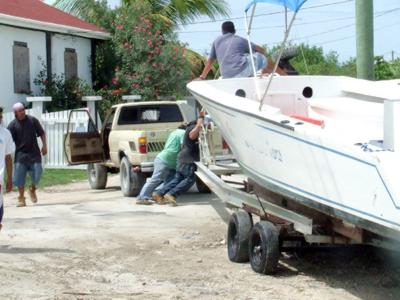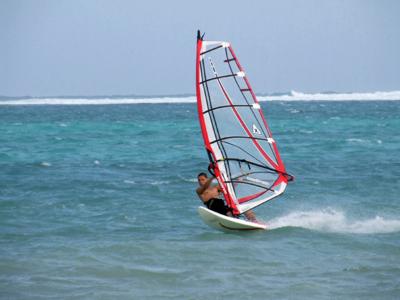 |
San Pedro residents board up homes and properties in anticipation of Felix.
|
 |
Approximately 5,000 people evacuated the cayes to seek higher ground.
|
 |
The Belize Coast Guard was stationed in San Pedro Monday through Wednesday in case their assistance was needed from the impact of Hurricane Felix. They stood prepared to assist the many people who evacuated off the island by boat.
|
 |
Measures to move boats to dry land were taken as a safety precaution.
|
 |
By Wednesday, the only impact of Hurricane Felix was some high waves and strong winds which enticed local wind surfers into the water.
|
 |
Once in the eye, the view was breathtaking even at night. The moon had just risen over the top of the eye wall and lightning lit up the eye wall all around. Photo by Hurricane Hunter Randy Bynon.
|
Just two weeks after Belize was threatened with the wrath of Hurricane Dean, all eyes were shifted from Dean to Hurricane Felix as it made its presence felt in the warm Caribbean waters this week. With Dean still an unsavory memory in the not too distant past, authorities were taking no chances, and by Sunday morning announcements had already gone out over the airwaves postponing the re-opening of schools countrywide.
On Monday, at the recommendation of the National Emergency Management Organization (NEMO), Governor General Sir Colville Young issued a proclamation declaring a state of emergency for the entire country of Belize. All across Central America, residents stocked up on water and food and nailed boards over windows to protect against the hurricane’s howling winds. Many who lived in low-lying areas were seeking higher ground. No one was about to take the pending storm lightly and Belize was no exception. Evacuation procedures went smoothly between the cayes of San Pedro Town and Caye Caulker with close to 5,000 people abandoning these coastal regions. In Belize City, people feared the worse. Clearly evident from last week’s flash flooding, residents and officials knew that just three inches of rain would prove to be disastrous to the city. With the impending storm, Felix promised much more than those inches. However, by Tuesday morning the green phase was called and the “coast is clear” was given. Yet, again, Belize was spared from the brunt of another catastrophic storm.
Hurricane Felix, a potentially catastrophic storm with 160 mile-per-hour (260-km- per-hour) winds, threatened on Monday, September 3rd, 2007, to plow along the Caribbean coast of Honduras and dump torrential rains across Central America. Hurricane Felix which is the sixth named storm, second hurricane and second Category 5 hurricane of the 2007 Atlantic hurricane season, formed from a tropical wave on August 31st, and passed through the southern Windward Islands on September 1st before strengthening to attain hurricane status. Felix brought heavy rains and high winds to Bonaire and Curacao in the Netherlands Antilles and to Aruba. There were reports of flooded streets and downed trees, but no word of any injuries.
Felix was upgraded to major hurricane status on September 2nd while located about 490 miles (790 km) southeast of Kingston, Jamaica. Rapid strengthening continued, and later that day the hurricane attained Category 4 status on the Saffir-Simpson Hurricane Scale with the pressure dropping to 957 mbar; this corresponded to a falling rate of 3.4 mbar per hour, which the National Hurricane Center remarked as “one of the more rapid deepening rates we have observed.” Felix was showing strong signs of going straight down the middle of Belize as a Category four or five storm. That would have meant sure devastation in Belize City, the country’s largest and most densely packed population center.
On September 3rd, the hurricane was downgraded to Category 4 status, but was re-upgraded to a Category 5 hurricane that same night. Hurricane Felix made landfall early Tuesday as a fearsome Category 5 storm in a swampy area just south of the border between Nicaragua and Honduras in a region historically known as the Mosquito Coast. The point at which Felix reached land is home to thousands of indigenous people who live in wooden shacks, depend on canoes for transportation and had no way out. Its winds screamed at 160 mph and Felix’s eye - so perfectly formed and distinct it could be seen on satellite photos - was accompanied by an 18-foot wall of water. Metal roofs flew through the air, witnesses said before most communications with the area were severed.
In Honduras, the government was letting water out of dams in an attempt to reduce flooding, and 10,000 people were being evacuated from the capital. Rain was pelting down in sheets late Tuesday in La Ceiba on Honduras’ coast and the streets were flooded waist-deep in water. As of press time, Tropical depression Felix was rapidly weakening over the mountains of Central America, according to the National Hurricane Center’s 5:00 p.m. forecast. Heavy rains were expected on Wednesday, September 5th, across northern Nicaragua, El Salvador and Honduras, as tropical depression Felix heads west at about 9 mph, slowly dissipating as it goes. A release stated that in Nicaragua, at least 21 people were killed and over 200 are missing (Reuters).

|





